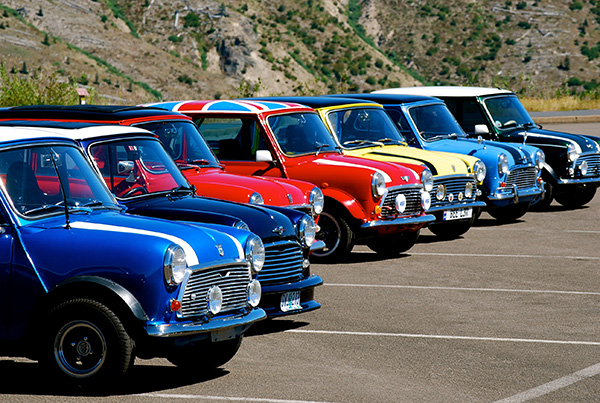
Small cars used to be a compromise. The original Mini changed that idea for good. It proved a compact footprint could be fun, clever, and surprisingly practical. From postwar fuel shortages to modern city streets, the Mini story is really the story of innovative design that keeps finding new ways to fit people’s lives.
From Problem to Icon
Late 1950s Britain wanted a car that sipped fuel, fit tight streets, and still carried a family. Engineer Alec Issigonis answered with the Mini in 1959. He pushed the engine sideways, moved the wheels out to the corners, and freed up interior space you could actually use. The result felt stable, turned in sharply, and seated four without the bulk of larger sedans.
John Cooper Enters the Chat
Racing constructor John Cooper saw a lightweight chassis with huge potential. Working with the factory, he tuned the engine, upgraded brakes, and created the Mini Cooper and later the Cooper S. Rally wins followed, including Monte Carlo victories in the 1960s. The message reached everyday drivers quickly. Small could be quick, and agility could beat raw horsepower on the right road.
Packaging That Changed the Industry
Transverse engine. Front wheel drive. Tiny wheels at the corners. These choices were not just tricks to save space. They became a blueprint for modern compacts. By pushing mechanical parts forward and outward, Issigonis created a flat floor and a boxy cabin with headroom and legroom that felt a class up.
Today you see the same logic in many hatchbacks. Short overhangs make parking easy, and a tall roof keeps adults comfortable in the back. The Mini showed how to do it without feeling cheap inside.
Design Language: Friendly Face, Serious Purpose
The Mini shape is simple to sketch, which is one reason it became a cultural object. Round lamps, upright glass, and a floating roof make it look cheerful at a glance. Underneath that friendly face is a serious goal. Visibility is wide, the dash is close, and the driver sits near the center of the wheelbase.
That placement helps the car rotate predictably, which builds the go kart feeling fans love. Form met function, and the car felt honest about what it was trying to do.
Through the 70s and 90s
Fuel crises, new safety rules, and changing tastes hit small cars hard. The Mini stayed relevant because it fit the times. Bands toured in them, students learned to drive in them, and city dwellers loved the footprint. Aftermarket parts kept old cars on the road.
The community grew around shared experience rather than status. Even when the original tooling aged, the shape still turned heads.
2001 and Onward: The BMW Revival
When the modern MINI arrived in 2001, it kept the stance and the character but added crash structure, modern electronics, and higher grade interiors. Designers kept the wheels pushed out, the roofline clean, and the cabin playful. Toggle switches and circular themes nodded to the past without feeling stuck there.
Performance models carried the Cooper S badge with turbo power and a chassis that felt planted on fast bends. The idea stayed the same. Make it small but feel special.
Why Drivers Still Choose It Today
Owners rarely pick a Mini by accident. They want steering that talks to them and a cabin that feels like a place, not a bin of parts. They want a car that fits tight alleys, yet still carries friends on a weekend run to the coast. The shape announces personality without shouting.
Maintenance matters with any performance leaning small car, yet the payoff is daily. Good tires, fresh suspension bits, and the right alignment keep the playful feel alive for years.
Thinking About a Classic or a Modern MINI
Classic models reward careful inspection. Rust, electrical age, and parts history make a big difference. Modern MINIs trade carburetors for direct injection, turbos, and advanced electronics. They deliver real speed and daily comfort, but they deserve precise service on timing components, cooling, and oil specification.
In both eras, a well sorted car feels light on its feet and turns every short errand into a reason to take the long way home.
Keep Your MINI Happy with Portland Motor Works in Portland and Redmond, OR
At Portland Motor Works, we understand why people bond with these cars. Our team services classic and modern MINIs with the same attention to feel and responsiveness that made the brand famous. We handle routine care, timing and cooling repairs, suspension refreshes, and performance alignments that preserve the crisp turn in and planted stance.
If you are shopping for your first MINI, we offer pre-purchase inspections that flag the costly items before you sign. If you already own one, we can build a maintenance plan that fits how you drive, city or coast, daily or weekend.
Visit our Portland or Redmond location and let us help your MINI deliver that small car magic every time you turn the key.